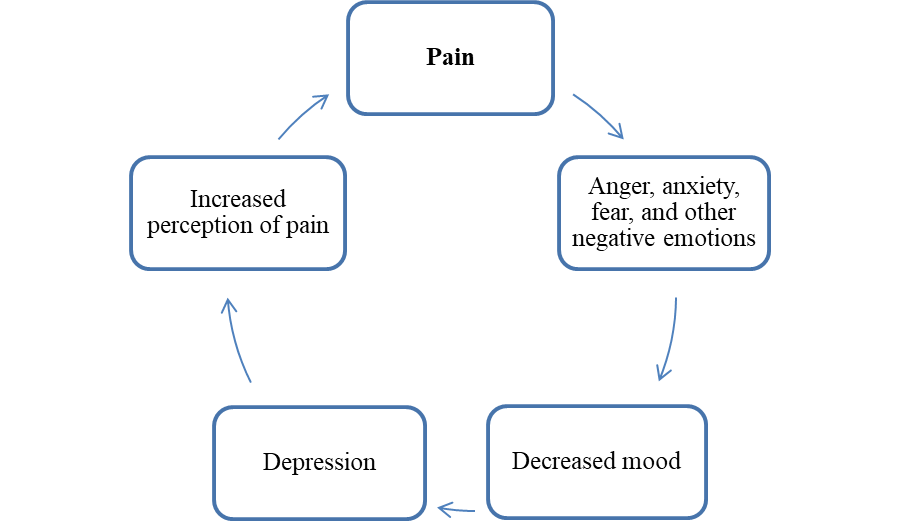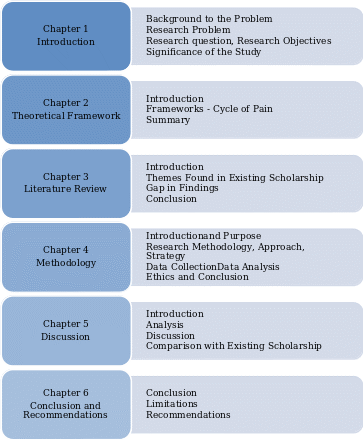Purpose of the Project
Similar to physical pain, psychological distress has a significant effect on people’s everyday lives. People who go through the psychological pain cycle experience a consistent worsening of their mental health. Nonetheless, it is possible that some factors improve or worsen people’s threshold for being susceptible to distress. Additionally, people’s experiences with non-psychological pain may differ in the socio-economic field, including how mental pain affects their health, employment, and personal relationships. Thus, the topic is the link between the cycle of psychological pain and people’s socioeconomic outcomes and the influence of culture on people’s resilience to pain in this cycle.
The purpose of this research is two-fold – it is to review the socioeconomic factors and cultural influences in the relation to people’s phycological pain and resilience to such pain. First, the goal of the project is to review the cycle of psychological pain in the socio-economic context. This means that the study will consider how the socioeconomic environment of people influences their experiences with mental pain, and how this pain can impact socioeconomic factors of living. Additionally, the study will consider the cultural impact on mental distress threshold and people’s pain tolerance. This part of the study will aim to analyze how various cultures contribute to one’s expression and healing of non-physical pain.
Research Questions
In order to analyze the existing scholarship on the topics of mental pain, socio-economic outcomes, and cultural influence, several research questions are suggested:
- What are the cycles of psychological pain?
- What are the socio-economic outcomes of non-physical pain?
- How does one’s culture influence their perception of mental pain?
- Does culture impact one’s tolerance and threshold to emotional pain?
Research Objectives
The research objectives of the study are as follows:
- To investigate the current knowledge about the cultural impact on psychological pain and socio-economic outcomes.
- To interview people from different cultures in order to determine their view of mental pain and their tolerance to it.
- To establish through data analysis whether culture influences people’s perception of psychological pain in the socio-economic context.
Personal Learning Objectives
One of the personal objectives of this study is for me to better understand the cycle of non-physical pain. While the process of healing a physical condition is well-researched in the healthcare field, mental health improvement remains an area of potential discovery. Next, I aim to gain a deeper perspective on the outcomes of mental pain and people’s differing responses to distress, which can be influenced by their cultural background. It is clear that people’s surroundings greatly influence how they act and think (Assari et al., 2018). Thus, the idea that their pain threshold is also impacted is in alignment with this assumption, and this study may help me depict the problem of non-physical pain from a different angle. The final goal is to gather more experience performing research studies in the sphere of psychological well-being.
Relevant Past Studies/Literature Review
As the research questions consider several topics related to mental health, one can present a variety of studies exploring mental pain. First, psychological pain can be described as a feeling of suffering that does not have a physical origin, although it can be a consequence of a physically present condition (Cooper, Booker, and Spanswick, 2003). Experiences of shame, embarrassment, bereavement, and loss may be causes of emotional pain (van Kleef et al., 2016). As can be seen, it is intimately tied with social interactions and one’s psychological needs and attachments.
Cooper, Booker, and Spanswick (2003) describe the psychological pain cycle, including five main steps, four of which contribute to the worsening of one’s well-being. These five stages are pain, distress, impoverished mood, depression, and increased perception of pain (Figure 1). Therefore, when a person experiences pain, it causes other negative emotions such as anger or fear. In turn, these feelings affect one’s desire to be active and participate in healing, which leads to greater symptoms of recurring psychological pain or mental conditions that decrease tolerance to pain. As this cycle continues, the person becomes more susceptible to emotional pain.

As the cycle of emotional pain demonstrates, the latter can have substantial effects on people’s lives. According to McLachlan and Gale (2018), psychological distress contributes to the development of unhealthy habits, dependencies, and chronic conditions. The impact of such pain on one’s body is a socio-economic outcome of health. Individuals exposed to continuous distress may be at risk of cardiovascular disease, arthritis, lung disease, and other problems (McLachlan and Gale, 2018). Assari et al. (2018) contributed to this finding, suggesting that inequalities in life accumulate together with one’s feeling of emotional pain. Celeste and Fritzell (2018) find that economic conditions and mental pain are intertwined, as they influence one another, contributing to the cycle of pain and decreasing one’s tolerance to pain in the future. These studies show that the pain cycle is influenced by socio-economic factors, and it also has consequences on people’s well-being and environment.
Culture is another factor that has been shown to influence the response to the pain of different people. In an older study of the relationship between culture and pain, Peacock and Patel (2008) concluded that culture determines not only one’s internal response to pain but also one’s decision to seek clinical help. Thus, one can the that culture can play a role in one’s response to pain, but the extent of this connection is not well-researched.
De Vaus et al. (2018) discovered that rumination and suppression of emotions and negative thoughts have a much larger place in Western cultures, which leads to prolonged healing periods, complicated grief, depression, and other mental conditions. Interestingly, Immordino-Yang, Yang, and Damasio (2016) found that people’s emotional regulation affects the way they process pain. Here, the emotional intensity is connected to a better understanding of healing, while suppression is implicitly related to the lack of self-knowledge. Therefore, based on these studies, one may see why the connection between one’s culture and the perception of pain is important to investigate.
Sources of Data
In this research, primary and secondary data will be used as the basis of the investigation. First, secondary data will consist of studies that explore the cycle of psychological pain and its connection to people’s socio-economic outcomes and cultural characteristics. This information will form the basis for the collection of primary data. It will also guide the research questions and the creation of the interview to discuss people’s experiences with mental pain effectively.
Second, the main primary source of data will be used for qualitative analysis. To collect qualitative data, the investigator will perform semi-structured interviews with the selected group of participants. They will be asked to talk about their experience with emotional and psychological pain and the ways they deal with it in everyday life. The participants will also discuss their cultural background and its potential impact on the ways they feel and suppress pain. Primary data will be collected from one group of 10-15 individuals, and each interview will take about 20 minutes to complete.
Proposed Methodology
Research Approach
The approach chosen for this study is qualitative. The subject matter of this research allows one to consider the participants’ unique views of the situation, which calls for a qualitative investigation (Aspers and Corte, 2019). Moreover, an examination of different cultural influences on people’s resilience to mental pain also requires an in-depth investigation. For topics that wish to concentrate on a particular problem without introducing hypotheses before collecting data, a qualitative approach is the most suitable (Aspers and Corte, 2019). As the research questions show, this project should employ a qualitative methodology.
Research Strategy
As noted above, the research will unfold using a strategy based on a quantitative methodology. First, the participants will be asked to provide demographic data in order to enrich the sample and determine the participants’ cultural backgrounds. This detail is vital for several research questions considered in this paper, namely the connection between one’s culture and their view of psychological pain. The qualitative investigation will be completed with the help of semi-structured interviews to allow participants to add vital information if they want. The interviewee will meet with each participant separately to allow the person to share their opinion without pressure. Each interview will have questions, but the investigator will consider adding questions and guiding the discussion if the participant has more to say.
Data Analysis
The results of the interviews will be investigated by the researcher in order to find themes and combine them into a narrative about the participants’ experiences with pain. Thus, the thematic analysis is chosen as the main analysis approach. A descriptive approach that discusses participants’ experiences with pain allows the investigator to collect data in a coherent manner and note potential connections or patterns in the individuals’ answers.
Limited/Anticipation Problems
This research presents a rather pressing problem; however, as the literature review shows, there exists a dearth of similar studies that could become the foundation for this investigation. Thus, a variety of issues can arise during the completion of this project. For instance, semi-structured interviews may not reveal any knowledge that could be used to appraise the participants’ mental pain in the socioeconomic sphere. Moreover, they may not yield any conclusions or offer a narrative. Nevertheless, as qualitative studies do not need to prove a hypothesis, the lack of patterns can also serve as a viable conclusion for the project.
Outline of Chapters
One can see the outline of chapters for future work in Figure 2. It shows both the sequence of the chapters in the paper and their structure and short description. Due to the qualitative approach with secondary and primary data, several chapters will have two smaller segments to separate analyses.

Outline of Expected Schedule
As the project requires significant time, a timeline for the research is presented in Table 1 below.
Table 1. Project Timeline/Plan.
Reference List
Aspers, P. and Corte, U. (2019) ‘What is qualitative in qualitative research’, Qualitative Sociology, 42(2), pp. 139-160.
Assari, S., Preiser, B., Lankarani, M.M. and Caldwell, C.H. (2018) ‘Subjective socioeconomic status moderates the association between discrimination and depression in African American Youth’, Brain Sciences, 8(4), p. 71.
Celeste, R.K. and Fritzell, J. (2018) ‘Do socioeconomic inequalities in pain, psychological distress and oral health increase or decrease over the life course? Evidence from Sweden over 43 years of follow-up’, Journal of Epidemiology & Community Health, 72(2), pp. 160–167.
Cooper, R.G., Booker, C.K., and Spanswick, C. (2003) ‘What is pain management, and what is its relevance to the rheumatologist?’, Rheumatology, 42, pp. 1133–1137.
De Vaus, J., Hornsey, M.J., Kuppens, P. and Bastian, B. (2018) ‘Exploring the East-West divide in prevalence of affective disorder: a case for cultural differences in coping with negative emotion’ Personality and Social Psychology Review, 22(3), pp. 285–304.
Immordino-Yang, M.H., Yang, X.F. and Damasio, H. (2016) ‘Cultural modes of expressing emotions influence how emotions are experienced’, Emotion, 16(7), pp. 1033–1039.
McLachlan, K.J. and Gale, C.R. (2018) ‘The effects of psychological distress and its interaction with socioeconomic position on risk of developing four chronic diseases’, Journal of psychosomatic research, 109, pp. 79–85.
Meerwijk, E.L., Mikulincer, M. and Weiss, S.J. (2019) ‘Psychometric evaluation of the tolerance for mental pain scale in United States adults’, Psychiatry Research, 273, pp. 746–752.
Peacock, S. and Patel, S. (2008) ‘Cultural influences on pain’, Reviews in Pain, 1(2), pp. 6–9.
van Kleef, G.A., Cheshin, A., Fischer, A.H. and Schneider, I.K. (2016) ‘The social nature of emotions’, Frontiers in Psychology, 7, p. 896.
